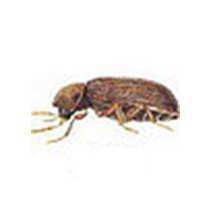(by the kind permission of Bayer)

Description
Order: Coleoptera ("sheath wings")
Characteristics: Forewings hard and leathery, meeting along mid-line of dorsal surface; hindwings membranous, sometimes lacking; biting mouthparts; well developed thorax; complete metamorphosis with egg, larval, pupal and adult stages.
Family: Anobiidae
Species Characteristics: Antennae of commonly encountered species 11-segmented with loose club-like tip; prothorax more or less covering downward-turned head; 5-segmented tarsi.
-
Biscuit Beetle (Drug-Store Beetle) (Stegobium paniceum)
Adult, 2-3.5mm long; colour, reddish-brown; body has dense covering of short yellowish hairs; base of thorax not humped.
-
Related species are the Tobacco Beetle (Lasioderma serricorne) and the Common Furniture Beetle (Anobium punctatum).
Areas where found
The Biscuit Beetle is a cosmopolitan pest. It is widely found in shops and domestic larders, infesting a wide variety of dried vegetable matter. In a warm atmosphere there may be as many as four generations per year.
Importance as a pest
Stegobium paniceum is a pest of cereal products, e.g. flour, bread, breakfast cereals, spices, beverage, concentrates and even drugs - indeed there have been reports of it infesting poisonous substances such as strychnine, belladonna and aconite. Infested products may lose value or cause contamination of other products and packaging may be damaged, the larvae reputedly being able to penetrate tinfoil and sheet lead. Books and manuscripts may also be attacked.
Life-Cycle
Over a period of about 3 weeks the female Biscuit Beetle will lay, singly, about 100 eggs, either in the foodstuff or in the surrounding areas. At 19-24oC they hatch in 1-2 weeks to produce very tiny, active larvae which wander about and may penetrate packing to infest the foodstuffs inside. Development takes 2-5 months, during which time the larvae go through four moults to reach a full-grown length of 5mm. Eventually they become incapable of movement and construct cells of food particles and saliva in which to pupate. The pupal stage lasts 9-18 days, but the adults may then remain in the cocoons for up to two weeks before emerging. On emergence, the adults disperse, living (without feeding) for up to 8 weeks.
Control
Assessment of infestation
A variety of trapping techniques are available for measuring stored product beetle infestations. These include pit fall traps, bait bags, insect probe traps, and adhesive traps. Whatever system is employed adequate records must be kept.
-
Hygiene/management
Stores should be soundly constructed to ensure maintenance of correct storage conditions and allow for easy cleaning.
They should be insulated, well ventilated and damp-proof. Cracks and crevices, which may provide harbourages for the beetles, should be kept to a minimum.
Commodities should be stacked neatly above the floor level using pallets, away from walls and should not touch the ceiling. A gap between stacks will allow for ventilation, regular inspection, cleaning and, if necessary, treatment with insecticides. Appropriate stock rotation is important and if possible there should be a one-way passage of commodities through the premises. The careful choice of packaging can help to deter insect attack. Generally, thick, tough materials with a smooth, shiny finish are preferred. Packs should be strong and well sealed.
It is important to ensure that there are no food residues (stored commodities or secondary sources e.g. birds' nests) in which beetles can breed and develop to infest new materials. All infested commodities should be destroyed or fumigated. Stores should be kept scrupulously clean and farm stores should be thoroughly cleaned before harvest.
All grain taken into store should be dried to a suitable moisture content (MC) and temperature e.g. <15%MC and <15oC and maintained in that condition.
-
Insecticidal control
Insecticides can be applied to the fabric of stores concentrating on potential insect harbourages. Alternatively it may be appropriate to employ grain protectants.


